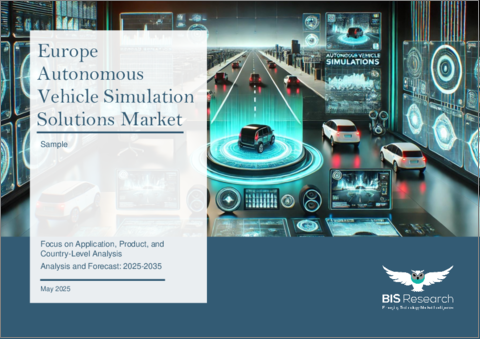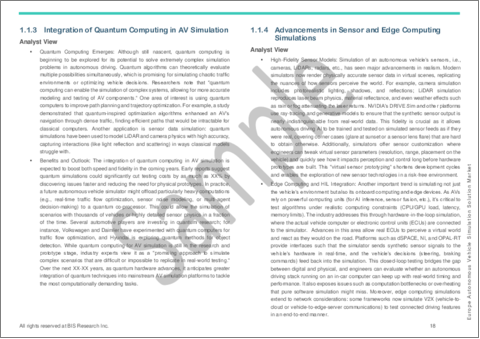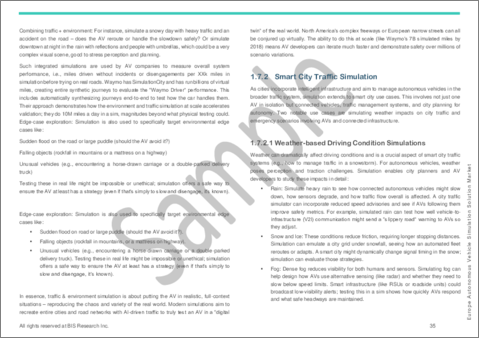|
|
市場調査レポート
商品コード
1735899
欧州の自律走行車シミュレーションソリューション市場:用途別、製品別、国別 - 分析と予測(2025年~2035年)Europe Autonomous Vehicle Simulation Solutions Market: Focus on Application, Product, and Country-Level Analysis - Analysis and Forecast, 2025-2035 |
||||||
カスタマイズ可能
|
|||||||
| 欧州の自律走行車シミュレーションソリューション市場:用途別、製品別、国別 - 分析と予測(2025年~2035年) |
|
出版日: 2025年05月30日
発行: BIS Research
ページ情報: 英文 124 Pages
納期: 1~5営業日
|
全表示
- 概要
- 図表
- 目次
欧州の自律走行車シミュレーションソリューションの市場規模は、2024年に4億650万米ドルとなりました。
同市場は、12.45%のCAGRで拡大し、2035年には14億9,590万米ドルに達すると予測されています。EUの厳格な安全・排ガス法の下、自動車メーカーやハイテク企業はADAS(先進運転支援システム)や完全自律走行車の導入を加速させており、これが欧州の自律走行車シミュレーションソリューション市場の成長を促進しています。EUのHorizon Europe研究資金やEuro NCAPのプロトコル開発などのプログラムの結果、高忠実度でリーズナブルな価格の仮想テストプラットフォームへのニーズが高まっています。アムステルダムのコネクテッド・インフラ実験やミュンヘンのデジタル交通管理など、スマートシティ構想の拡大により、欧州のデータ主権フレームワーク内に収容されるクラウドベースのシミュレーションサービスに新たな可能性が生まれつつあります。しかし、高度なシミュレーション用ハードウェアとソフトウェアの高価なコスト、欧州のさまざまな道路環境のシミュレーションの難しさ、GDPRに基づくデータ保護規制の厳しさなどが、普及の妨げとなっています。
| 主要市場統計 | |
|---|---|
| 予測期間 | 2025年~2035年 |
| 2025年の評価額 | 4億6,260万米ドル |
| 2035年の予測 | 14億9,590万米ドル |
| CAGR | 12.45% |
欧州における自律走行車シミュレーションソリューション市場は、EUの安全およびデータ保護に関する法律が変化する中、OEM、ティア1サプライヤー、研究機関が拡張性があり、リーズナブルな価格の検証プラットフォームを求める中で急成長しています。標準化されたシナリオ・ライブラリ(OpenSCENARIO、OpenDRIVE)上に構築された、都市、郊外、高速道路環境の忠実度の高いデジタル・ツインにより、実際のプロトタイプのようなコストや危険を伴うことなく、自動駐車、ADAS機能、完全な自律性の現実的なテストが可能になります。クラウドネイティブアーキテクチャを採用したエラスティックなHPCバックエンドにより、利害関係者は何百万ものシナリオを同時に実行することができ、エッジに配置されたシミュレーションノードは、コネクテッドカーを含むユースケースの低レイテンシー検証を容易にします。
AIを活用したシナリオ生成、センサー融合テスト、機械学習ベースの検証モジュールの開発は、Horizon Europeや各国の研究開発プロジェクトからの資金提供によって加速しています。ミュンヘン、アムステルダム、ストックホルムのスマートシティプロジェクトでは、デジタルと物理的な試験領域を接続することで、仮想設定を改善するための実世界データのインプットを提供しています。一方、厳格なGDPR規制とUNECE WP.29サイバーセキュリティガイドラインによって、強化されたソフトウェアスタックと安全で匿名化されたデータパイプラインへの投資が推進されています。
特殊なシミュレーションソフトウェアやオンプレミス機器への高額な先行投資、独自のツールチェーン間の互換性のギャップ、訓練を受けたシミュレーションエンジニアの不足などが障害となっています。しかし、こうした障害は、協力的なコンソーシアムや、コンテナ化されたモジュラーシステムへの依存の高まりによって軽減されつつあります。将来的には、5G対応のエッジコンピューティング、AIを活用したシナリオオーケストレーション、汎欧州的な認証のハーモナイゼーションの融合により、欧州が自律走行車の検証技術における世界リーダーになることが期待されます。
市場セグメンテーション
セグメンテーション1:エンドユーザー別
- 自動車OEMおよび自律走行技術開発企業
- ティア1およびティア2部品メーカー
- 大学・研究センター、テクノロジー企業、規制機関
セグメンテーション2:自律走行レベル別
- レベル1および2(部分的運転支援)
- レベル3および4(準自動運転~高自動運転)
- レベル5(完全自動化)
セグメンテーション3:製品別
- ソフトウェア
- サービス
セグメンテーション4:展開別
- オンプレミス
- クラウド
セグメンテーション5:地域別
- 欧州ドイツ、フランス、英国、スペイン、その他
欧州自律走行シミュレーションソリューション市場動向と促進要因・課題
市場動向
- EUの道路環境をリアルに再現するための高忠実度デジタルツイン・シナリオライブラリ(OpenSCENARIO、OpenDRIVE)の採用
- スケーラブルなHPCバックエンドを備えたクラウドネイティブなシミュレーションプラットフォームの成長
- 仮想環境におけるマルチセンサー(LiDAR、レーダー、カメラ)の融合テストの統合
- Euro NCAPプロトコルやUNECE WP.29ガイドラインを通じた標準化の取り組み
- OEM、Tier-1サプライヤー、研究機関を結ぶ共同エコシステム
市場促進要因
- EUの厳しい安全・排ガス規制(Euro NCAP、GDPRに準拠したデータ処理)
- AVシミュレーションR&Dに資金を提供するHorizon Europeと各国のR&D補助金
- ミュンヘンやアムステルダムなどの都市におけるスマートシティの展開により、コネクテッドビークルの検証が必要
- 仮想検証対実走行テストにおけるOEMのコスト削減目標
- ADASの信頼性と安全性の検証に対する消費者ニーズの高まり
市場の課題
- 専用シミュレーションソフトウェアとオンプレミスハードウェアへの高額な先行投資
- 欧州の多様な地形、天候、交通ルールのモデリングの複雑さ
- GDPRに準拠したデータの匿名化と共有シミュレーションデータセットのサイバーセキュリティの確保
- 独自のシミュレーションツールチェーン間の相互運用性のギャップ
- シミュレーションエンジニアリングと検証手法のスキル不足
製品/イノベーション戦略:製品セグメントは、エンドユーザー(自動車OEMおよび自律走行技術開発企業、ティア1およびティア2部品メーカー、大学・研究センター、テクノロジー企業、規制機関)、自律走行レベル別(レベル1および2(部分的な運転支援)、レベル3および4(準~高度自動化)、レベル5(完全自動化))、製品別(ソフトウェアおよびサービス)、展開別(オンプレミスおよびクラウド)、自律走行シミュレーションソリューションのさまざまな用途を理解するのに役立ちます。欧州の自律走行車シミュレーションソリューション市場は、継続的な技術の進歩、投資の増加、規制遵守の重要性に対する意識の高まりにより、大きく拡大する見通しです。
成長/マーケティング戦略:欧州の自律走行シミュレーション・ソリューション市場は急成長しています。欧州の自律走行シミュレーションソリューション市場は、既存および新興の市場参入企業に大きな機会を提供しています。このセグメントで取り上げている戦略には、M&A、製品投入、提携・協力、事業拡大、投資などがあります。企業が市場での地位を維持・強化するために好む戦略には、主に製品開発が含まれます。
競合戦略:本調査で分析・プロファイリングした欧州自律走行車シミュレーションソリューション市場の主要企業プロファイルには、自動車および自動車領域の専門知識を有する専門家が含まれています。さらに、提携、合意、協力などの包括的な競合情勢は、市場の未開拓の収益ポケットを理解する上で読者を支援することが期待されます。
当レポートでは、欧州の自律走行車シミュレーションソリューション市場について調査し、市場の概要とともに、用途別、製品別、国別の動向、および市場に参入する企業のプロファイルなどを提供しています。
目次
エグゼクティブサマリー
第1章 市場
- 動向:現状と将来への影響評価
- AI駆動型シミュレーションとデジタルツイン
- クラウドベースおよびリアルタイムシミュレーションプラットフォーム
- AVシミュレーションにおける量子コンピューティングの統合
- センサーとエッジコンピューティングのシミュレーションの進歩
- シミュレーションプラットフォームへのNeRFの統合
- リアルタイムレンダリングのためのガウススプラッティングの進歩
- サプライチェーンの概要
- 研究開発レビュー
- 規制状況
- 比較分析:データ駆動型シミュレーション手法と従来のシミュレーション手法
- 自律走行車シミュレーションソリューションで活用されるシミュレーション手法
- シミュレーションのアプリケーションユースケース
- 主要イベントの影響分析
- 市場力学の概要
第2章 地域
- 地域サマリー
- 自律走行車シミュレーションソリューション市場(地域別)
- 欧州
- 地域概要
- ビジネス上の促進要因
- ビジネス上の課題
- 主要な市場参入企業
- 用途
- 製品
- 欧州(国別)
第3章 市場-競合ベンチマーキングと企業プロファイル
- 今後の見通し
- 地理的評価
- 市場シェア分析
- 戦略的取り組み(パートナーシップ、買収、製品発売)
- 競合ベンチマーキング
- 競争優位性と市場差別化要因
- スタートアップと新規参入者
- データ駆動型シミュレーションの新興企業
- 企業プロファイル
- AVL List GmbH
- Dassault Systemes
- dSPACE GmbH
- Hexagon AB
- rFpro
- aiMotive
第4章 調査手法
List of Figures
- Figure 1: Europe Autonomous Vehicle Simulation Solutions Market (by Scenario), $Million, 2025, 2030, and 2035
- Figure 2: Europe Autonomous Vehicle Simulation Solutions Market (by End Users), $Million, 2025, 2030, and 2035
- Figure 3: Europe Autonomous Vehicle Simulation Solutions Market (by Level of Autonomy), $Million, 2025, 2030, and 2035
- Figure 4: Europe Autonomous Vehicle Simulation Solutions Market (by Product), $Million, 2025, 2030, and 2035
- Figure 5: Europe Autonomous Vehicle Simulation Solutions Market (by Deployment), $Million, 2025, 2030, and 2035
- Figure 6: Key Events
- Figure 7: Supply Chain Analysis of Autonomous Vehicle Simulation Solutions Market
- Figure 8: Patent Analysis (by Country), January 2021-January 2025
- Figure 9: Patent Analysis (by Company), January 2021-October 2024
- Figure 10: Impact Analysis of Market Navigating Factors, 2025-2035
- Figure 11: Germany Autonomous Vehicle Simulation Solutions Market, $Million, 2024-2035
- Figure 12: France Autonomous Vehicle Simulation Solutions Market, $Million, 2024-2035
- Figure 13: U.K. Autonomous Vehicle Simulation Solutions Market, $Million, 2024-2035
- Figure 14: Spain Autonomous Vehicle Simulation Solutions Market, $Million, 2024-2035
- Figure 15: Rest-of-Europe Autonomous Vehicle Simulation Solutions Market, $Million, 2024-2035
- Figure 16: Strategic Initiatives, January 2021-October 2024
- Figure 17: Share of Strategic Initiatives, January 2022-January 2025
- Figure 18: Data Triangulation
- Figure 19: Top-Down and Bottom-Up Approach
- Figure 20: Assumptions and Limitations
List of Tables
- Table 1: Market Snapshot
- Table 2: Opportunities across Region
- Table 3: Trends Overview
- Table 4: Pricing Analysis of Autonomous Vehicle Simulation Solutions ($USD/Year), 2024
- Table 5: Autonomous Vehicle Testing Regulations
- Table 6: Comparative Analysis of Traditional vs. Data-Driven Autonomous Vehicle Simulation Methods
- Table 7: Autonomous Vehicle Simulation Solutions Market (by Region), $Million, 2024-2035
- Table 8: Europe Autonomous Vehicle Simulation Solutions Market (by Application), $Million, 2024-2035
- Table 9: Europe Autonomous Vehicle Simulation Solutions Market (by Level of Autonomy), $Million, 2024-2035
- Table 10: Europe Autonomous Vehicle Simulation Solutions Market (by Product), $Million, 2024-2035
- Table 11: Europe Autonomous Vehicle Simulation Solutions Market (by Deployment), $Million, 2024-2035
- Table 12: Germany Autonomous Vehicle Simulation Solutions Market (by Application), $Million, 2024-2035
- Table 13: Germany Autonomous Vehicle Simulation Solutions Market (by Level of Autonomy), $Million, 2024-2035
- Table 14: Germany Autonomous Vehicle Simulation Solutions Market (by Product), $Million, 2024-2035
- Table 15: Germany Autonomous Vehicle Simulation Solutions Market (by Deployment), $Million, 2024-2035
- Table 16: France Autonomous Vehicle Simulation Solutions Market (by Application), $Million, 2024-2035
- Table 17: France Autonomous Vehicle Simulation Solutions Market (by Level of Autonomy), $Million, 2024-2035
- Table 18: France Autonomous Vehicle Simulation Solutions Market (by Product), $Million, 2024-2035
- Table 19: France Autonomous Vehicle Simulation Solutions Market (by Deployment), $Million, 2024-2035
- Table 20: U.K. Autonomous Vehicle Simulation Solutions Market (by Application), $Million, 2024-2035
- Table 21: U.K. Autonomous Vehicle Simulation Solutions Market (by Level of Autonomy), $Million, 2024-2035
- Table 22: U.K. Autonomous Vehicle Simulation Solutions Market (by Product), $Million, 2024-2035
- Table 23: U.K. Autonomous Vehicle Simulation Solutions Market (by Deployment), $Million, 2024-2035
- Table 24: Spain Autonomous Vehicle Simulation Solutions Market (by Application), $Million, 2024-2035
- Table 25: Spain Autonomous Vehicle Simulation Solutions Market (by Level of Autonomy), $Million, 2024-2035
- Table 26: Spain Autonomous Vehicle Simulation Solutions Market (by Product), $Million, 2024-2035
- Table 27: Spain Autonomous Vehicle Simulation Solutions Market (by Deployment), $Million, 2024-2035
- Table 28: Rest-of-Europe Autonomous Vehicle Simulation Solutions Market (by Application), $Million, 2024-2035
- Table 29: Rest-of-Europe Autonomous Vehicle Simulation Solutions Market (by Level of Autonomy), $Million, 2024-2035
- Table 30: Rest-of-Europe Autonomous Vehicle Simulation Solutions Market (by Product), $Million, 2024-2035
- Table 31: Rest-of-Europe Autonomous Vehicle Simulation Solutions Market (by Deployment), $Million, 2024-2035
- Table 32: Market Share
- Table 33: Strategic Initiatives (Partnerships, Acquisitions, and Product Launches)
- Table 34: Competitive Advantages and Market Differentiators
- Table 35: Startup and New Entrants
- Table 36: Emerging Players in Data-Driven Simulation
Introduction to Europe Autonomous Vehicle Simulation Solutions Market
The Europe autonomous vehicle simulation solutions market was valued at $406.5 million in 2024 and is expected to grow at a CAGR of 12.45% and reach $1,495.9 million by 2035. Under strict EU safety and emissions laws, automakers and tech companies are accelerating the implementation of advanced driver-assistance systems (ADAS) and fully autonomous vehicles, which is driving growth in the European market for autonomous vehicle simulation solutions. The need for high-fidelity, reasonably priced virtual testing platforms is growing as a result of programs like the EU's Horizon Europe research funding and Euro NCAP's developing protocols. The expansion of smart-city initiatives, such as Amsterdam's connected infrastructure experiments and Munich's digital traffic management, is opening up new possibilities for cloud-based simulation services housed inside European data-sovereignty frameworks. Widespread adoption is still hampered by the expensive cost of sophisticated simulation hardware and software, the difficulty of simulating various European road settings, and the strict GDPR-driven data protection regulations.
Market Introduction
| KEY MARKET STATISTICS | |
|---|---|
| Forecast Period | 2025 - 2035 |
| 2025 Evaluation | $462.6 Million |
| 2035 Forecast | $1,495.9 Million |
| CAGR | 12.45% |
The market for autonomous vehicle simulation solutions in Europe is growing quickly as OEMs, Tier-1 suppliers, and research institutions look for scalable, reasonably priced validation platforms in light of changing EU safety and data-protection laws. Built on standardised scenario libraries (OpenSCENARIO, OpenDRIVE), high-fidelity digital twins of urban, suburban, and highway environments allow for realistic testing of automatic parking, ADAS features, and complete autonomy without the cost and danger of actual prototypes. Elastic HPC back-ends with cloud-native architectures enable stakeholders to execute millions of scenarios concurrently, and simulation nodes deployed on the edge facilitate low-latency validation for use cases including connected vehicles.
The development of AI-driven scenario generation, sensor-fusion testing, and machine-learning-based validation modules is accelerated by funding from Horizon Europe and national R&D projects. By connecting the digital and physical testing realms, smart-city projects in Munich, Amsterdam, and Stockholm offer real-world data inputs to improve virtual settings. In the meantime, investments in fortified software stacks and safe, anonymised data pipelines are driven by the strict GDPR regulations and the UNECE WP.29 cybersecurity guidelines.
High upfront expenditures for specialised simulation software and on-premises gear, compatibility gaps across proprietary toolchains, and a scarcity of trained simulation engineers are all obstacles. These obstacles are being lessened, though, by cooperative consortiums and an increasing reliance on containerised, modular systems. In the future, Europe is expected to become a global leader in autonomous vehicle validation technology thanks to the convergence of 5G-enabled edge computing, AI-powered scenario orchestration, and pan-European certification harmonisation.
Market Segmentation
Segmentation 1: by End Users
- Automotive OEMs and Autonomous Driving Technology Development Companies
- Tier-1 and Tier-2 Component Manufacturers
- University and Research Centers, Technology Companies, and Regulatory Bodies
Segmentation 2: by Level of Autonomy
- Levels 1 and 2 (Partially Assisted Driving)
- Levels 3 and 4 (Semi to High Automation)
- Level 5 (Full Automation)
Segmentation 3: by Product
- Software
- Services
Segmentation 4: by Deployment
- On-Premises
- Cloud
Segmentation 5: by Region
- Europe: Germany, France, U.K., Spain, and Rest-of-Europe
Europe Autonomous Vehicle Simulation Solutions Market Trends, Drivers and Challenges
Market Trends
- Adoption of high-fidelity digital twins and scenario libraries (OpenSCENARIO, OpenDRIVE) for realistic EU road environments
- Growth of cloud-native simulation platforms with scalable HPC back-ends
- Integration of multi-sensor (LiDAR, radar, camera) fusion testing in virtual environments
- Standardization efforts via Euro NCAP protocols and UNECE WP.29 guidelines
- Collaborative ecosystems linking OEMs, Tier-1 suppliers, and research institutions
Market Drivers
- Stringent EU safety and emissions regulations (Euro NCAP, GDPR-compliant data handling)
- Horizon Europe and national R\&D grants funding AV simulation R\&D
- Smart-city deployments in cities like Munich and Amsterdam requiring connected-vehicle validation
- OEM cost-reduction goals for virtual validation vs. on-road testing
- Rising consumer demand for verified ADAS reliability and safety
Market Challenges
- High upfront investment in specialized simulation software and on-premises hardware
- Complexity in modeling diverse European terrains, weather, and traffic rules
- Ensuring GDPR-compliant data anonymization and cybersecurity for shared simulation datasets
- Interoperability gaps between proprietary simulation toolchains
- Skills shortage in simulation engineering and validation methodologies
How can this report add value to an organization?
Product/Innovation Strategy: The product segment helps the reader understand the different applications of autonomous vehicle simulation solutions on end users (automotive OEMs and autonomous driving technology development companies, tier-1 and tier-2 component manufacturers, and university and research centers, technology companies, and regulatory bodies), by level of autonomy (levels 1 and 2 (partially assisted driving), levels 3 and 4 (semi to high automation), and level 5 (full automation)), by product (software and services), by deployment (on-premises and cloud). The Europe autonomous vehicle simulation solutions market is set for significant expansion with ongoing technological advancements, increased investments, and growing awareness of the importance of regulatory compliance.
Growth/Marketing Strategy: The Europe autonomous vehicle simulation solutions market has been growing rapidly. The autonomous vehicle simulation solutions market in Europe offers enormous opportunities for existing and emerging market players. Some of the strategies covered in this segment are mergers and acquisitions, product launches, partnerships and collaborations, business expansions, and investments. The strategies preferred by companies to maintain and strengthen their market position primarily include product development.
Competitive Strategy: The key players in the Europe autonomous vehicle simulation solutions market analyzed and profiled in the study include professionals with expertise in the automobile and automotive domains. Additionally, a comprehensive competitive landscape such as partnerships, agreements, and collaborations are expected to aid the reader in understanding the untapped revenue pockets in the market.
Key Market Players and Competition Synopsis
The companies profiled in the Europe autonomous vehicle simulation solutions market have been selected based on inputs gathered from primary experts who have analyzed company coverage, product portfolio, and market penetration.
Some of the prominent names in this market are:
- AVL List GmbH
- Dassault Systemes
- dSPACE GmbH
- Hexagon AB
- rFpro
- aiMotive
Table of Contents
Executive Summary
Scope and Definition
1 Markets
- 1.1 Trends: Current and Future Impact Assessment
- 1.1.1 AI-Driven Simulation and Digital Twins
- 1.1.2 Cloud-Based and Real-time Simulation Platforms
- 1.1.3 Integration of Quantum Computing in AV Simulation
- 1.1.4 Advancements in Sensor and Edge Computing Simulations
- 1.1.5 Integration of NeRF in Simulation Platforms
- 1.1.6 Advancements in Gaussian Splatting for Real-Time Rendering
- 1.2 Supply Chain Overview
- 1.2.1 Value Chain Analysis
- 1.2.2 Pricing Analysis
- 1.3 Research and Development Review
- 1.3.1 Patent Filing Trend (by Country, by Company)
- 1.4 Regulatory Landscape
- 1.4.1 Europe Autonomous Vehicle Testing Regulations
- 1.4.2 ISO and SAE Standards for Simulation and Testing
- 1.4.3 Government and Policy Initiatives Supporting AV Simulation
- 1.5 Comparative Analysis: Data-Driven vs. Traditional Simulation Methods
- 1.6 Simulation Methodologies Utilized in Autonomous Vehicle Simulation Solutions
- 1.6.1 Log-Based Simulation Methods
- 1.6.1.1 Standard Log Replay
- 1.6.1.2 AR-Enhanced Log Replay
- 1.6.2 Model-Based Simulation Methods
- 1.6.2.1 Abstract Dynamics Simulations
- 1.6.2.2 Physics-Based Simulations
- 1.6.2.3 Sensor Simulation Techniques
- 1.6.2.4 Traffic and Environment Simulations
- 1.6.3 Data-Driven Simulation Methods
- 1.6.3.1 Neural Radiance Fields (NeRF)
- 1.6.3.2 Gaussian Splatting Techniques
- 1.6.3.3 Generative Adversarial Networks (GANs)
- 1.6.3.4 Diffusion Models
- 1.6.3.5 Reinforcement Learning (RL)-Based Simulations
- 1.6.3.6 Self-Supervised Learning (SSL) World Models
- 1.6.3.7 Latent Space Simulation Models
- 1.6.3.8 Surrogate Modeling for AV Simulation
- 1.6.4 Hybrid Simulation Methods
- 1.6.4.1 Mixed Neural Simulation
- 1.6.4.2 End-to-End AV Simulation Platforms
- 1.6.1 Log-Based Simulation Methods
- 1.7 Application Use Cases for Simulation
- 1.7.1 ADAS and Autonomous Driving Validation
- 1.7.1.1 Lane Assist and Collision Avoidance Simulation
- 1.7.1.2 Automated Parking Assistance Simulation
- 1.7.1.3 Traffic Sign and Object Detection Simulation
- 1.7.1.4 Traffic and Environment Simulation
- 1.7.2 Smart City Traffic Simulation
- 1.7.2.1 Weather-based Driving Condition Simulations
- 1.7.2.2 Emergency Vehicle and Pedestrian Interaction Simulations
- 1.7.3 Sensor and Perception Simulation
- 1.7.3.1 LiDAR, RADAR, and Camera-Based Perception Simulation
- 1.7.3.2 Sensor Fusion and Multi-Modal Sensing Simulation
- 1.7.4 Vehicle Dynamics Testing
- 1.7.4.1 Mechanical System Response Testing
- 1.7.4.2 Braking and Acceleration Simulation
- 1.7.5 Connectivity and V2X Simulation
- 1.7.5.1 5G and Vehicle Communication Simulations
- 1.7.5.2 Cybersecurity and Threat Response Testing
- 1.7.1 ADAS and Autonomous Driving Validation
- 1.8 Impact Analysis for Key Events
- 1.9 Market Dynamics Overview
- 1.9.1 Market Drivers
- 1.9.1.1 Rising Adoption of ADAS and Autonomous Vehicles
- 1.9.1.2 Increasing Demand for Cost-Effective Testing and Validation
- 1.9.1.3 Demand for High-Fidelity Simulations
- 1.9.1.4 Growing Concerns on Road Safety and Reduced Testing Risks
- 1.9.1.5 Advancements in AI and Machine Learning for Simulations
- 1.9.2 Market Restraints
- 1.9.2.1 High Costs of Simulation Software and Hardware
- 1.9.2.2 Complexity in Real-World Scenario Replication
- 1.9.2.3 Data Privacy and Security Concerns
- 1.9.3 Market Opportunities
- 1.9.3.1 Expansion of Smart Cities and Connected Infrastructure
- 1.9.3.2 Rising Demand for Cloud-Based Simulation Solutions
- 1.9.1 Market Drivers
2 Regions
- 2.1 Regional Summary
- 2.2 Autonomous Vehicle Simulation Solutions Market (by Region)
- 2.3 Europe
- 2.3.1 Regional Overview
- 2.3.2 Business Drivers
- 2.3.3 Business Challenges
- 2.3.4 Key Market Participants
- 2.3.5 Application
- 2.3.6 Product
- 2.3.7 Europe (by Country)
- 2.3.7.1 Germany
- 2.3.7.1.1 Application
- 2.3.7.1.2 Product
- 2.3.7.2 France
- 2.3.7.2.1 Application
- 2.3.7.2.2 Product
- 2.3.7.3 U.K.
- 2.3.7.3.1 Application
- 2.3.7.3.2 Product
- 2.3.7.4 Spain
- 2.3.7.4.1 Application
- 2.3.7.4.2 Product
- 2.3.7.5 Rest-of-Europe
- 2.3.7.5.1 Application
- 2.3.7.5.2 Product
- 2.3.7.1 Germany
3 Markets - Competitive Benchmarking & Company Profiles
- 3.1 Next Frontiers
- 3.2 Geographic Assessment
- 3.2.1 Market Share Analysis
- 3.2.2 Strategic Initiatives (Partnerships, Acquisitions, and Product Launches)
- 3.3 Competitive Benchmarking
- 3.3.1 Competitive Advantages and Market Differentiators
- 3.3.2 Startup and New Entrants
- 3.3.3 Emerging Players in Data-Driven Simulation
- 3.4 Company Profiles
- 3.4.1 AVL List GmbH
- 3.4.1.1 Overview
- 3.4.1.2 Top Products/Product Portfolio
- 3.4.1.3 Top Competitors
- 3.4.1.4 Target Customers/End Users
- 3.4.1.5 Key Personnel
- 3.4.1.6 Analyst View
- 3.4.1.7 Market Share, 2023
- 3.4.2 Dassault Systemes
- 3.4.2.1 Overview
- 3.4.2.2 Top Products/Product Portfolio
- 3.4.2.3 Top Competitors
- 3.4.2.4 Target Customers/End Users
- 3.4.2.5 Key Personnel
- 3.4.2.6 Analyst View
- 3.4.2.7 Market Share, 2023
- 3.4.3 dSPACE GmbH
- 3.4.3.1 Overview
- 3.4.3.2 Top Products/Product Portfolio
- 3.4.3.3 Top Competitors
- 3.4.3.4 Target Customers/End Users
- 3.4.3.5 Key Personnel
- 3.4.3.6 Analyst View
- 3.4.3.7 Market Share, 2023
- 3.4.4 Hexagon AB
- 3.4.4.1 Overview
- 3.4.4.2 Top Products/Product Portfolio
- 3.4.4.3 Top Competitors
- 3.4.4.4 Target Customers/End Users
- 3.4.4.5 Key Personnel
- 3.4.4.6 Analyst View
- 3.4.4.7 Market Share, 2023
- 3.4.5 rFpro
- 3.4.5.1 Overview
- 3.4.5.2 Top Products/Product Portfolio
- 3.4.5.3 Top Competitors
- 3.4.5.4 Target Customers/End Users
- 3.4.5.5 Key Personnel
- 3.4.5.6 Analyst View
- 3.4.5.7 Market Share, 2023
- 3.4.6 aiMotive
- 3.4.6.1 Overview
- 3.4.6.2 Top Products/Product Portfolio
- 3.4.6.3 Top Competitors
- 3.4.6.4 Target Customers/End Users
- 3.4.6.5 Key Personnel
- 3.4.6.6 Analyst View
- 3.4.6.7 Market Share, 2023
- 3.4.1 AVL List GmbH
4 Research Methodology
- 4.1 Data Sources
- 4.1.1 Primary Data Sources
- 4.1.2 Secondary Data Sources
- 4.1.3 Data Triangulation
- 4.2 Market Estimation and Forecast





